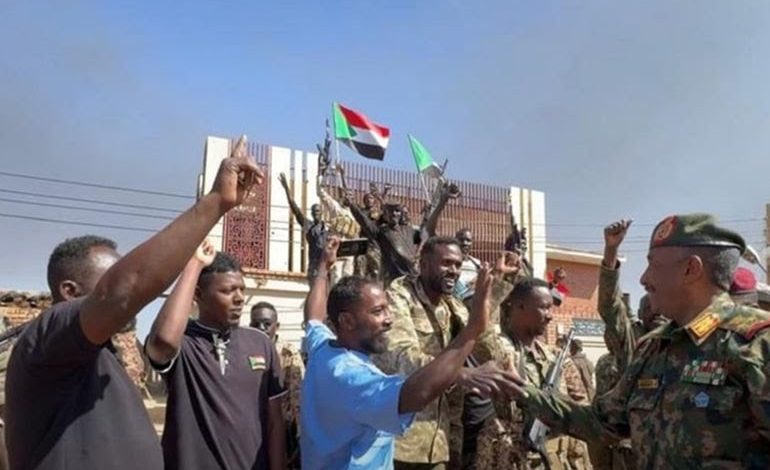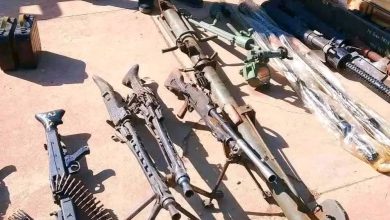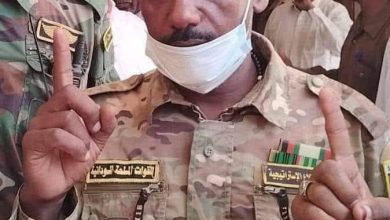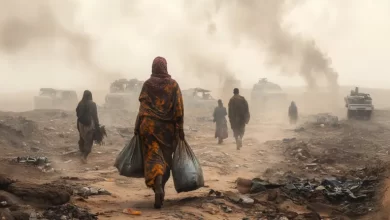Does the Sudanese Army Impose Its Will on Khartoum After Lifting the Siege of the General Command?

Wars are full of surprises, often not ending the way those who ignite them expect. In World War II, Hitler’s massive attack on the Soviet Union ended in the heart of Berlin, with Soviet forces reaching the German capital after years of bloody fighting.
The German attack led to a counterattack, turning the tide, and Moscow, which was once threatened by a German invasion, ended up controlling all of Eastern Europe, including East Germany, for about half a century, until the fall of the Berlin Wall and the dissolution of the Soviet Union in 1991.
From Europe to Africa, while the geography, number of combatants, and their identities differ, the essence is similar. After nearly two years of fighting in Sudan, the Sudanese army announced its recapture of the Al-Jaili oil refinery, located about 70 kilometers north of Khartoum, and its control over the military manufacturing area north of the city of Bahri.
The army also announced the arrival of its forces at the Signal Corps in central Bahri and the lifting of the siege on the General Command headquarters of the armed forces. This marked the continuation of its counteroffensive momentum, which included solidifying control over the Sennar State in southeastern Sudan, then the city of Madani, the capital of the Al-Jazeera State in central Sudan, and reaching strategic locations in Khartoum. This opens the door for the major prize: regaining full control over the capital once again.
These developments reflect a shift in the direction of the war, which had previously seemed to favor the Rapid Support Forces (RSF), which had controlled most of western Sudan and parts of the central region, extending to southeastern Sudan. At that time, fears escalated that Sudan was on the verge of total chaos similar to what occurred in Somalia in the 1990s, with the collapse of the state, turning the country into fiefdoms fought over by warlords, and tribes competing for control over the nation’s resources.
This was indicated by the widespread destruction in the capital, which included the airport, ministries, banks, hospitals, and schools, amidst a total paralysis of daily life, as well as internal displacement and migration to neighboring countries, affecting about a quarter of Sudan’s population.
The RSF did not offer an attractive model of governance, as looting, kidnapping, and killings spread across the vast areas under their control, earning them widespread revulsion among the general population. Fears arose that the war and chaos could spread to neighboring countries, potentially affecting Libya, Chad, Egypt, Ethiopia, and Eritrea, as well as the wider Red Sea region, the Horn of Africa, Sub-Saharan Africa, and North Africa.
From Expansion to Contraction
As time went on, the RSF obtained advanced weapons that were not previously available in Sudan and were not seen at the beginning of the conflict, such as Kornet anti-tank guided missiles, drones equipped with missiles, suicide drones, heavy modern armored vehicles, and anti-drone systems.
The RSF obtained these advanced weapons through regional support, using the Um Jaras airport in Chad, which stirred internal conflicts in Chad. The ruling elite in Chad belongs to the Zaghawa tribe, whose members are fighting against the RSF in Darfur, on the Sudanese-Chadian border.
Reports from the United Nations and major newspapers like The New York Times spread about weapons and ammunition being transported through Chad to the RSF. Efforts were then made to open an additional supply line via the Ethiopian border. The RSF launched an attack towards the Al-Jazeera State at the end of 2024, and by mid-2024, it reached Sennar State, which borders Ethiopia.
Here’s the translation of the text you provided:
Despite the Sudanese Army’s Success in Expelling the Rapid Support Forces from Sennar State and the City of Madani, Their Remnants Expand into New Areas
Although the Sudanese army succeeded in expelling the Rapid Support Forces (RSF) from Sennar State and the city of Madani, the capital of Al-Jazeera State, the fleeing RSF remnants expanded into new areas, exploiting the vast spaces of Sudan to reach regions in the White Nile and Blue Nile states, which border South Sudan and Ethiopia.
These developments have had a significant impact on Khartoum’s relations with Juba. With widespread accusations of South Sudanese fighters joining the RSF in Al-Jazeera and other areas, there were assaults on several South Sudanese citizens following the recapture of Madani. This triggered outrage in South Sudan, leading to angry mobs attacking the shops and homes of Sudanese citizens residing in Juba, in January of this year. Both the Sudanese army and the South Sudanese government have called on citizens to remain calm and avoid being drawn into ethnic or identity-based attacks.
These events added a new crisis for South Sudan, which has been heavily impacted by the closure of its oil export pipeline through Sudan’s ports due to the war. Moreover, RSF leader Hamidti previously accused Tigrayan elements in Ethiopia of fighting alongside the Sudanese army, highlighting some of the regional dimensions of the conflict and its repercussions on neighboring countries and their ties to other internal struggles.
The Push for Negotiation
Several regional and international parties have attempted to push the leadership of both the Sudanese army and the RSF into negotiations. Washington hosted a conference in Geneva, Switzerland, in August 2024, but the army refused to attend. The battlefield situation was not in the army’s favor, and attending negotiations at that time would have meant conceding the RSF’s territorial gains politically.
Negotiation proposals included treating the warring parties as equals, without recognizing the army as the legitimate representative of the state but rather as a party in conflict with the RSF. In contrast, the army insisted that it represented the state’s legitimacy against a rebel group.
The army’s refusal to attend the Geneva talks came at a cost. In January 2025, the U.S. Treasury Department added army commander Abdel Fattah al-Burhan to its sanctions list, following the inclusion of RSF leader Hamidti a few days earlier, in an effort to pressure both leaders to engage in talks.
Washington was also upset by the involvement of competing parties in the conflict, such as Moscow, which shifted its support to the Sudanese army after previously backing the RSF through the Wagner Group. Russia even vetoed a British resolution at the UN Security Council, which the Sudanese army saw as a threat to the country’s security by equating the army with the RSF. Additionally, the U.S. is concerned about Russia’s request for a naval base in Port Sudan, which would give it a presence in the Red Sea, along with the resumption of Sudan-Iran relations, which had been severed since 2016. Tehran has also supplied the Sudanese army with drones.
The Military’s Counteroffensive
In contrast to calls for negotiations, and specifically after the end of the rainy season in 2024, the Sudanese army launched a major counteroffensive by September 2024. This operation involved elements from the General Intelligence Service’s Operations Authority, the Mobilized Battalions, and the Joint Force, which included most of the former Darfur rebel groups. The army successfully crossed several key bridges over the Nile to break the RSF’s control over the western Nile areas.
In the early stages of its attack, the army lifted the siege of its camp in Kadro, in the Bahri area. This was followed by further military successes, including breaking the siege of the armored corps in Al-Shajara Military Area, clearing the path to the Jabra district, seizing Hamidti’s house, and ultimately lifting the siege of the General Command of the Armed Forces in central Khartoum.
This attack is aimed at reclaiming the capital, which would enhance the army’s legitimacy through tangible achievements on the ground. It is hoped that this will either decisively end the battle militarily or at least improve the army’s position to negotiate from a position of strength.
The Sudanese army has successfully tightened the noose around the RSF in Khartoum, repeatedly bombing weapons shipments along the main supply route for the RSF, which comes from Chad, through Darfur, to Omdurman, and then to the capital via the Jebel Awlia Bridge south of Khartoum. Consequently, the RSF has struggled to secure supplies and reinforce its defensive lines against the army.
RSF’s Response
In response to their battlefield setbacks, the RSF has resorted to a scorched earth policy, destroying the Jili Oil Refinery before withdrawing, and attacking power plants in areas under the army’s control using swarms of drones. They destroyed the transformers at the Al-Gazala station, plunging the strategic city of Merowe in Northern State into darkness. They also attacked the transformers at the Shawak transformer station in Al-Qadarif, causing power outages in Al-Qadarif, Kassala, and Sennar in eastern and southeastern Sudan.
The RSF has also attempted to seize full control of Darfur by mobilizing fighters to attack El Fasher, the capital of North Darfur, the last stronghold of the army in the region. In January 2025, the RSF issued a 48-hour ultimatum for the army to evacuate El Fasher before launching an attack. The RSF attacked the city from five fronts simultaneously, but the army’s air force bombed the advancing columns, and the army, along with the Joint Force, repelled the attack, which was the largest of its kind in terms of troop numbers.
In Khartoum, the RSF is attempting to regroup and establish new defensive lines to halt the army’s advance. Khartoum differs from other battlegrounds, with its high-rise buildings and densely packed residential blocks providing the RSF with a defensive advantage suited to urban warfare. Their capabilities in light and medium weaponry, sniping, anti-tank weapons, and quick mobility using Tatacher vehicles, along with their use of civilian homes for shelter and ammunition storage, make them difficult to dislodge.
On the other hand, the army relies on intelligence, drone surveillance, special operations units, and the highly experienced intelligence operatives in urban warfare. These components aim to target the RSF’s strongholds, command centers, weapons depots, supply lines, and sniper positions through airstrikes and ambushes, preparing the ground for a ground assault to control key areas, and linking the besieged army units within Khartoum with advancing forces from other fronts, particularly from Al-Jazeera State.
Turkish Mediation Efforts
Several Western and regional entities have attempted mediation efforts to no avail. However, on December 13, 2024, Turkish President Recep Tayyip Erdogan contacted Sudan’s Sovereign Council Chairman and army commander Abdel Fattah al-Burhan, offering Turkish mediation between the Sudanese army and the UAE, the RSF’s primary ally. A few days after the phone call, Turkish Deputy Foreign Minister Burhan Dinç met with al-Burhan in Port Sudan, and al-Burhan expressed his welcome for Turkish mediation, though he later stated that there was no future for the RSF in Sudan.
While al-Burhan did not openly reject Turkish mediation, it appears he is not currently counting on it to avoid hindering the army’s battlefield progress or giving the RSF a chance to regroup, rearm, or change the course of the conflict. Moreover, regaining control of Khartoum would represent a major victory for the army, strengthening its narrative as the legitimate force and its political and economic importance, which is supported by popular enthusiasm for the army across Sudan, unlike in RSF-controlled areas, where continuous clashes between the RSF fighters and civilians are reported.
As previously mentioned, the retaking of Madani paves the way for the Khartoum battle, which is currently underway. Therefore, the prospects for negotiations will improve once Khartoum is fully restored, but the negotiations will then be between a state authority controlling the capital and most of the country’s states, and a rebellious entity controlling parts of Darfur. This may increase pressure on the RSF, compelling its leaders to accept the army’s terms.
As the conflict’s landscape in Khartoum takes shape, it seems less likely that the state will collapse, and Sudan may have passed the risk of “Somalization.” The country may return to a situation similar to the past decades, marked by rebellions in its periphery—a dangerous state of affairs that previously led to the secession of South Sudan in 2011.
However, the difference now is that the RSF does not enjoy widespread support in Darfur, where deep divisions persist between Arab and African tribal groups, which is evident in the fighting between the Joint Force, representing Darfurian movements, and the RSF. Moreover, there are even disagreements within the Arab groups that support the RSF, as figures like Musa Hilal, leader of the Mahamid tribe, support the Sudanese army against the RSF despite having family ties to Hamidti. Hilal had previously commanded Hamidti before his rise to prominence. Thus, the likelihood of a secession scenario similar to South Sudan seems slim.
“According to Al Jazeera Net.”



